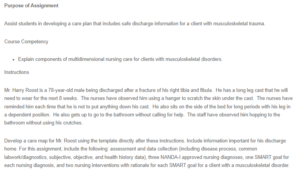Designing a Care Map with Safe Discharge Information for a Client with Musculoskeletal Trauma
| Assessment
and Data Collection |
Three NANDA-I Approved Nursing Diagnosis | One Smart Goal for EACH Nursing Diagnosis | Two Nursing Interventions with Rationale for EACH Nursing Diagnosis |
| Disease Process: Musculoskeletal trauma
Common Lab work/Diagnostics: X-rays to visualize the fractures. Blood tests to reveal any systemic problem contributing to the patient’s presentation.
Assessment Data (consider subjective, objective, and heath history): Subjective: Patient’s age, comorbidity, family history of musculoskeletal disorders, tobacco, and alcohol use.
Objective: Patient’s gait, ability to ambulate and participate in activities of daily living, and BMI.
History: History of fractures, motor vehicle accidents, and musculoskeletal disorders.
|
Nursing Diagnosis:
Impaired skin integrity-related abrasions and lacerations evidenced by pressure due to cast application and the patient’s scratching of the skin.
Nursing Diagnosis: Risk for peripheral neurovascular dysfunction due to the possibility of vascular and nerve compression related to the applied cast.
Nursing Diagnosis Deficient knowledge related to unfamiliarity with the treatment process, evidenced by the patient scratching the skin beneath the cast
|
SMART Goal:
The patient will demonstrate behaviors to prevent skin breakdown by the time of discharge.
SMART Goal: The patient will maintain perfusion to the areas to which the cast is applied during the entire time of cast application.
SMART Goal: The patient will demonstrate knowledge by verbalization of why the cast was applied to his limb and the necessary measures to prevent injury by the time of discharge. |
1. Protect the applied cast and the skin beneath by massaging the skin around the cast with alcohol. Alcohol has a drying effect and may help in toughening the skin.
2. Educate the patient and their other caregiver on the need to avoid inserting objects inside the cast. Inserting an object may increase skin and tissue injury (Parisien & McAlpine, 2019).
1. Apply ice around the cast intermittently for short durations. This may reduce hematoma and edema that impede circulation (Parisien & McAlpine, 2019). 2. Educate the patient on the need for routine mild exercise and ambulation. Exercise and ambulatory movements enhance blood flow and reduce venous pooling (Parisien & McAlpine, 2019).
1. Educate the patient on his suffering and why he should maintain the cast for the recommended time. This will enhance his accountability in self-care (Amarilla-Donoso et al., 2020). 2. Assess the patient’s knowledge of precautionary measures against tissue and skin injury. Knowing protective measures against skin injury will prevent the patient from engaging in behaviors that predispose him to injury (Amarilla-Donoso et al., 2020). |
References
Amarilla-Donoso, F. J., Roncero-Martín, R., Lavado-García, J., Canal-Macías, M. de, Pedrera-Canal, M., Chimpén-López, C., Toribio-Felipe, R., Rico-Martin, S., Barrios-Fernández, S., & López-Espuela, F. (2020). Impact of a postoperative intervention educational program on the quality of life of patients with hip fracture: A randomized, open-label controlled trial. International Journal of Environmental Research and Public Health, 17(24), 9327. https://doi.org/10.3390/ijerph17249327
Parisien, R. L., & McAlpine, K. J. (2019). The Boston technique for acute point-of-care single-practitioner fracture stabilization of the lower extremity. Patient Safety in Surgery, 13(1). https://doi.org/10.1186/s13037-019-0200-x
ORDER A PLAGIARISM-FREE PAPER HERE
We’ll write everything from scratch
Question

Client with Musculoskeletal Trauma
Purpose of Assignment
Assist students in developing a care plan that includes safe discharge information for a client with musculoskeletal trauma.
Course Competency
- Explain components of multidimensional nursing care for clients with musculoskeletal disorders.
Instructions
Mr. Harry Roost is a 78-year-old male being discharged after a fracture of his right tibia and fibula. He has a long leg cast that he will need to wear for the next 8 weeks. The nurses have observed him using a hanger to scratch the skin under the cast. The nurses have reminded him each time that he is not to put anything down his cast. He also sits on the side of the bed for long periods with his leg in a dependent position. He also gets up to go to the bathroom without calling for help. The staff have observed him hopping to the bathroom without using his crutches.
Develop a care map for Mr. Roost using the template directly after these instructions. Include information important for his discharge home. For this assignment, include the following: assessment and data collection (including disease process, common labwork/diagnostics, subjective, objective, and health history data), three NANDA-I approved nursing diagnoses, one SMART goal for each nursing diagnosis, and two nursing interventions with rationale for each SMART goal for a client with a musculoskeletal disorder.


